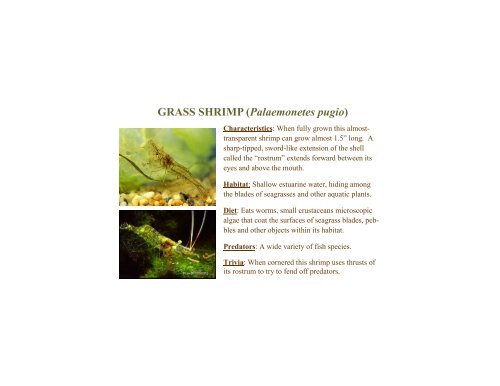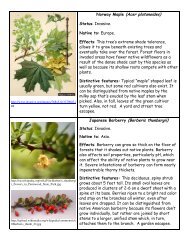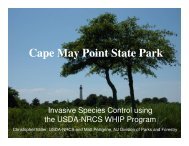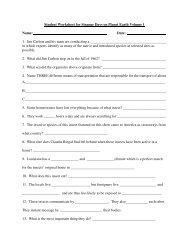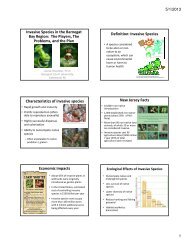Create successful ePaper yourself
Turn your PDF publications into a flip-book with our unique Google optimized e-Paper software.
<strong>GRASS</strong> <strong>SHRIMP</strong> (<strong>Palaemonetes</strong> <strong>pugio</strong>)<br />
Characteristics: When fully grown this almosttransparent<br />
shrimp can grow almost 1.5” long. A<br />
sharp-tipped, sword-like extension of the shell<br />
called the “rostrum” extends forward between its<br />
eyes and above the mouth.<br />
Habitat: Shallow estuarine water, hiding among<br />
the blades of seagrasses and other aquatic plants.<br />
Diet: Eats worms, small crustaceans microscopic<br />
algae that coat the surfaces of seagrass blades, pebbles<br />
and other objects within its habitat.<br />
Predators: A wide variety of fish species.<br />
Trivia: When cornered this shrimp uses thrusts of<br />
its rostrum to try to fend off predators.
GREAT BLUE HERON (Ardea herodias)<br />
Characteristics: Head to tail this bird is up to 4’ long,<br />
with a wingspan of up to 7’. Its feathers are mostly<br />
blue grey, but its face is white with a black stripe that<br />
connects to several long black “plume” feathers. It has<br />
a long yellow beak and long legs and usually holds its<br />
neck in an “S” shape when standing or flying.<br />
Habitat: All marshes and wetlands from fresh water<br />
lakes and streams to full salt ocean water<br />
Diet: Shrimp, fish, crabs, small mammals, frogs,<br />
snakes and small birds<br />
Predators: None. Herons are top predators.<br />
Trivia: This is the largest and most abundant North<br />
American heron
BALD EAGLE (Haliaeetus leucocephalus)<br />
Characteristics: Young bald eagles have brown<br />
feathers. Only when mature do they show the<br />
characteristic white head and tail associated with<br />
the species. Females are larger than males<br />
(wingspan: 8 feet, weight 9 lbs versus 6 feet and<br />
5 lbs for males).<br />
Diet: Mostly different types of fish, though they<br />
will eat frogs, snakes and even carrion (dead<br />
animals) when present in their habitat.<br />
Predators: None<br />
Habitat: Found along seacoasts, rivers, and large<br />
lakes. Usually prefers to roost and nest in hardwood<br />
(deciduous) trees near water and away<br />
from the influence humans.<br />
Other Trivia: National bird and symbol of<br />
United States of America.
BLACK DUCK (Anas rubripes)<br />
Characteristics: Gets its name from blackish<br />
brown feathers found on both males and females.<br />
Males often have a band of purple feathers on<br />
their wings. Both genders have yellow beaks and<br />
orange legs.<br />
Diet: Aquatic plants, clams, snails, insect larvae,<br />
frog eggs and small fish.<br />
Predators: Birds of prey eat young and weak<br />
adults. Snakes and rodents will eat their eggs<br />
Habitat: Fresh water and low salt environments<br />
including marshes, rivers, bays and streams.<br />
Trivia: This species can hybridize with another<br />
duck species, the mallard duck producing young<br />
that have characteristics of both species
BLUE CRAB (Callinectes sapidus)<br />
Characteristics: Fully grown blue crabs are 7” wide<br />
and 4” long and weigh up to 2 lbs. Blue crabs have 5<br />
pairs of legs. The front pair are powerful pincers and<br />
the back pair are adapted to be swimming paddles.<br />
Diet: Use claws to eat mollusks such as oysters and<br />
clams as well as small fish and aquatic plants.<br />
Predators: Fish such as drum, eel and croaker as<br />
well as other crabs.<br />
Habitat: Bottom of estuaries, as well as in channels<br />
within brackish marshes and tidal creeks.<br />
Trivia: Blue crab shells have two pigments: a blue<br />
one and a red one. In the living crab these make the<br />
crab brownish-green. When you cook the crab, the<br />
blue pigment breaks down, so the crab turns red.
AMERICAN BULLFROG (Rana catesbeiana)<br />
Characteristics: Can grow to 8” long and 1.5 lb<br />
weight, with females being larger than males.<br />
Usually green or brown on top and yellow or white<br />
on underside. Feet are webbed for swimming.<br />
Diet: Insects, crayfish, earthworms, leeches, snails,<br />
salamanders, other frogs and even small fish, birds<br />
and mammals when it can catch them.<br />
Predators: Snakes, snapping turtles, large fish,<br />
herons, opossums, skunks, and raccoons.<br />
Habitat: This aquatic amphibian can be found in<br />
various locations including marshes, rivers and<br />
streams, but it does not tolerate salty environments.<br />
Trivia: The deep-pitched breeding call of male bullfrogs<br />
is so loud that it can be heard half a mile away.
CLAPPER RAIL (Rallus longirostris)<br />
Characteristics: About the size of a chicken<br />
but with longer legs, this secretive bird rarely<br />
flies. Most feathers are grayish brown but there<br />
is a noticeable white patch under its tail. Its<br />
long orange beak curves slightly downwards.<br />
It gets its name from its distinctive rattling call<br />
which sounds like the “clapping” of a castanet.<br />
Diet: Prefers crabs and other crustaceans, but<br />
will eat small fish, insects and even seeds if<br />
needed.<br />
Predators: Eagles, hawks, owls and foxes.<br />
Rats, racoons and snakes eat eggs and chicks.<br />
Habitat: Saltwater Marshes.<br />
Trivia: A group of clapper rails is known as an<br />
"applause”
COMMON CRAYFISH (Cambarus bartonii)<br />
Characteristics: Although it looks like a lobster with<br />
its big claws, sharp snout and eyes on movable stalks,<br />
this animal reaches only 1.5” in size when fully grown.<br />
Its shell is usually brown, but the exact shade varies<br />
depending on what its habitat looks like.<br />
Diet: Worms, snails, tadpoles, small fish, insect larvae,<br />
aquatic plants<br />
Predators: Raccoons, opossums, snakes, and muskrats<br />
Habitat: Prefers streams, but may also be found in<br />
ponds. It often lives under rocks or in burrows at the<br />
edge of the water.<br />
Trivia: When scared it will flip its abdomen and shoot<br />
backwards, away from the threat
BLUE DASHER (Pachydiplax longipennis)<br />
Characteristics: This dragonfly grows to about 2”<br />
in length. Mature males have bright blue bodies and<br />
huge green eyes. Females have black bodies with<br />
yellow stripes.<br />
Habitat: Live near water because their larval form<br />
is aquatic. Prefer small, calm ponds but can be<br />
found almost anywhere freshwater is present.<br />
Diet: Adult: Mosquitoes and other small insects.<br />
Larva: Other aquatic insects and crustaceans.<br />
Predators: Birds eat adults. Fish and frogs eat the<br />
larvae.<br />
Trivia: Dragonflies are the world’s fastest insects.<br />
They can reach top flight speeds of between 20 and<br />
40 miles per hour.
FIDDLER CRAB (Uca pugnax)<br />
Characteristics: Shell can reach up to 1” in<br />
diameter. Adult males have one large and one<br />
small front claw. Adult females have two small<br />
front claws.<br />
Habitat: Lives in burrows in muddy areas with salt<br />
levels between that of rivers and that of the ocean.<br />
Diet: Dead plant and animal material (detritus) and<br />
small animals living between the mud grains.<br />
Predators: Blue crabs, rails, egrets, herons, and<br />
raccoons<br />
Trivia: Some male crabs are left clawed (have the<br />
big claw on the left), while others are right clawed.<br />
The males wave these big claws to attract mates.
EASTERN PEARLSHELL (Margaritifera margaritifera)<br />
Characteristics: Elongated oval shell can grow to<br />
4-5” in length. The shell has a dull brown exterior<br />
but its interior has a thick pearly covering. This<br />
animal is one source of freshwater pearls.<br />
Diet: Filters algae and microscopic animals from<br />
water using its gills<br />
Predators: Muskrat, otter, raccoon, turtles, catfish,<br />
freshwater drum<br />
Habitat: Burrows into sandy sediments, often<br />
between stones and pebbles. It likes fast flowing<br />
rivers and streams where the water is cool and rich<br />
in oxygen. It will not grow in polluted or murky<br />
water.<br />
Trivia: These animals can live for over 100 years.<br />
Their larvae are parasites that live on fish gills.
Hard Clam (Mercenceria mercenceria)<br />
Characteristics: This clam’s heavy shell can<br />
reach more than 4” in width. It is dull white<br />
or gray on the outside, but has a bright purple<br />
and shiny inside edge. Water containing food<br />
and oxygen is brought inside the animal’s<br />
shell using a muscular tube-like siphon.<br />
Diet: Single celled algae that it filters out of<br />
the water using its gills<br />
Predators: Moon snails, whelks, fish, crabs,<br />
waterfowl and shorebirds.<br />
Habitat: This clam prefers relatively shallow,<br />
brackish habitats where it burrows in sandy<br />
or muddy sediments.<br />
Trivia: This clam’s shell shows yearly<br />
growth rings that can be used to tell its age.
MARSH PERIWINKLE (Littoraria irrorata)<br />
Characteristics: This snail has a heavy grey or<br />
cream colored shell that can grow to 1.25” in<br />
length which protects the soft body inside.<br />
Habitat: Marshes in area where the water is at<br />
least half as salty as the ocean.<br />
Diet: Microscopic algae and fungi that grow on<br />
the surface of the mud and on plants growing in<br />
the marsh.<br />
Predators: Blue crabs, fish and terrapins<br />
Trivia: Because most of its predators live in<br />
water, this snail climbs up grass blades as the<br />
tide rises and then climbs back down to feed on<br />
the mud surface at low tide.
MASRH MEADOW <strong>GRASS</strong>HOPPER<br />
(Chorthippus curtipennis )<br />
Characteristics: Grow to about 1” in length, with<br />
females being larger than males. Its back is light<br />
brown and underside is yellow with black blotches.<br />
It has wings but usually jumps using its strong back<br />
legs.<br />
Habitat: Tall grasses in moist places such as<br />
marshes and the areas around lakes and streams.<br />
Does not like salty environments.<br />
Diet: Grasses and sedges.<br />
Predators: Spider, birds and small mammals including<br />
mice and voles.<br />
Trivia: The chirping sound made by these animals<br />
is created by rubbing their back legs against a<br />
ridged area on their wings.
LAUGHING GULL (Leucophaeus atricilla)<br />
Characteristics: This is a medium sized gull with a<br />
body length of 15-17”. In summer, the adult's back<br />
and wings are dark gray and their heads and wing<br />
tips are black. They lose their dark feathers when<br />
they molt in fall, so they are white-headed in winter.<br />
They get their name from their loud “ha-ha-ha” call.<br />
Habitat: Nests in large colonies in coastal marshes<br />
using grasses to build its nest<br />
Diet: Marine fish and crabs, worms, other birds’ eggs<br />
Predators: Other, larger gulls and birds of prey such<br />
as osprey and bald eagles<br />
Trivia: They sometimes steal food from Brown<br />
Pelicans by landing on their heads and stealing fish<br />
from their pouches.
SIX-SPOTTED FISHING SPIDER (Dolomedes triton)<br />
Characteristics: Can grow to 2.5” long, including its<br />
legs (females are larger than males). Its body is<br />
greenish brown with two white stripes. It gets its<br />
name from 6 pairs of white spots on its abdomen and<br />
6 black spots on its under side.<br />
Habitat: Slow flowing streams or ponds, and the<br />
marshes around them.<br />
Diet: Small fish, tadpoles, frogs, aquatic insects and<br />
crustaceans<br />
Predators: Large frogs, fish and birds<br />
Trivia: This spider can walk on water and also dives<br />
under the water in search of prey, taking a bubble of<br />
air with it so that it can breathe while submerged.
NORTHERN HOUSE MOSQUITO (Culex pipiens)<br />
Characteristics: This medium sized mosquito has<br />
wings about 1/8” long.<br />
Habitat: Larvae live in rainwater pools and other<br />
stagnant water bodies. Adults usually fly around in<br />
nearby habitats, but may enter homes to feed at night.<br />
Diet: Adults drink nectar. Females eat blood of birds<br />
or mammals, including humans, to get protein to<br />
make their eggs with. Larvae eat microscopic algae.<br />
Predators: Fish and salamanders eat the larvae.<br />
Birds, bats, spiders and frogs eat adults.<br />
Trivia: Culex pipiens is the most widely distributed<br />
mosquito in the world occurring on every continent<br />
except Antarctica.
MUMMICHOG (Fundulus heteroclitus)<br />
Characteristics: Fully grown this fish reaches 4.5”<br />
long. Its mouth is tilted upwards for catching food<br />
near the surface. Females are dull brown with dark<br />
vertical stripes, whereas males are green and have<br />
bright blue spots during mating season.<br />
Habitat: Although it tolerates a wide range of<br />
salinities, it tends to be found in shallow water<br />
areas with medium to with high salt content.<br />
Diet: Plants like eelgrass, small snails, fish eggs<br />
and larvae, salt marsh mosquito larvae, shrimp.<br />
Predators: Herons and other wading birds, blue<br />
crabs, larger fish<br />
Trivia: The mummichog became the first fish in<br />
space when specimens of this species were used in<br />
experiments on Skylab 3 in 1973.
MUSKRAT (Ondatra zibethicus)<br />
Characteristics: Muskrat’s stocky bodies are about a<br />
foot long and their tails are flat and scaly and about<br />
10” long. They have dense brown fur that traps air for<br />
insulation and buoyancy, and their back feet have are<br />
webbed toes for swimming.<br />
Habitat: Found in swamps, marshes and wetlands.<br />
They have a wide tolerance for salt, being found in<br />
freshwater habitats all the way to the coast.<br />
Diet: Mostly roots and shoots of plants such as<br />
cattails, but occasionally animals like frogs and fish.<br />
Predators: Racoons, fox, snakes, hawks, eagles.<br />
Trivia: In some Native American creation myths it<br />
was the muskrat who dove into the first ocean to bring<br />
up the mud from which the earth was made.
SEASIDE GOLDENROD (Solidago sempervirens)<br />
Characteristics: This perennial plant can grow up to 6<br />
- 8 feet tall and has distinctive yellow flowers at the<br />
top of its stems. Its leaves are fleshy with a shiny,<br />
waxy coating.<br />
Predators: Songbirds feed on goldenrod seeds, and<br />
small mammals like rabbits and mice eat its leaves.<br />
Nectar from this plant’s flowers is an important fuel<br />
for migrating monarch butterflies.<br />
Habitat: Found on beaches, dunes and in marshes<br />
exposed to seawater.<br />
Trivia: European folk law suggests that having this<br />
plant growing wild near your house brings good luck<br />
and may indicate the presence of buried treasure.
COMMON CATTAIL (Typha latifolia)<br />
Characteristics: This water-loving plant has long<br />
green leaves and distinctive, hot-dog shaped<br />
brown flower spikes. It can grow up to 10’ tall.<br />
Predators: Many insects as well as larger animals<br />
like geese and muskrats.<br />
Home to: Redwing blackbirds and many ducks<br />
and geese nest in them. Muskrats use their leaves<br />
to build their lodges and some songbirds use fluff<br />
from the flowers to line their nests.<br />
Habitat: Found in wet areas with low salt levels<br />
such as streams and lakes, and marshes.<br />
Trivia: Native Americans used this plant<br />
extensively as food, eating the flowers like<br />
corn-cobs and its rhizomes (underground stems)<br />
like potatoes
BAYBERRY (Myrica pensylvanica)<br />
Characteristics: This bushy plant has small,<br />
fragrant leaves which are tapered at each end. In<br />
the fall its branches are covered with distinctive<br />
small, blue-gray, waxy berries.<br />
Predators: Its berries are a favorite food of<br />
some species of birds, including tree swallows,<br />
bluebirds grouse and myrtle warblers.<br />
Habitat: Marshy or coastal habitats in areas<br />
flooded only rarely by high tides. Can tolerate<br />
soils with relatively high salt content.<br />
Trivia: In the old days, the fragrant wax<br />
covering bayberries was used to make candles.
CORD<strong>GRASS</strong> (Spartina alterniflora)<br />
Characteristics: Flowers of this grass grow on<br />
stiff stems that reach 3-5’ tall. It has smooth<br />
leaves that can be 2’ long and about ½” wide<br />
Predators: Leaves of this plant are eaten by mud<br />
snails. Its roots are a favorite food of snow geese.<br />
However, most things eat it only after it dies and<br />
becomes “detritus”.<br />
Home to: This plant’s dense stems give young fish<br />
and crabs a place to hide from predators. Ribbed<br />
mussels often live near the base of its stems.<br />
Habitat: Adapted to live in wet, muddy<br />
environments with high salt content.<br />
Trivia: The height of this plant depends on its<br />
position on the marsh: Plants nearer the water are<br />
taller than those further up the creek bank.
SWAMP ROSE MALLOW (Hibiscus moscheutos)<br />
Characteristics: This shrub dies back in winter and<br />
re-sprouts in spring, growing up to 7’ tall. Its leaves<br />
are triangular to heart shaped with smooth tops and<br />
velvety undersides. Its flowers are about 6” across,<br />
with white or pink petals, often with crimson centers.<br />
Predators: Many beetles eat its leaves. Hummingbirds<br />
and bumble bees drink nectar from its flowers.<br />
Some ducks and songbirds eat its seeds.<br />
Home to: Many species of frog, bird, snake and<br />
insect hide under its leaves or among its stems<br />
Habitat: Swamps, marshes and ditches with<br />
medium to low salt levels<br />
Trivia: Closely related to the plants that give us<br />
cotton as well as to the original marsh-mallow plant<br />
from which the candy gets its name
SWAMP SUNFLOWER (Helianthus angustifolius)<br />
Characteristics: This plant creates many<br />
branches each of which develops yellow, daisylike<br />
flowers at their ends. It grows up to ten feet<br />
tall and both its stems and narrow, pointy leaves<br />
are covered in numerous fine hairs.<br />
Predators: Its nectar is a favorite of many butterflies<br />
and bees. Its seeds are eaten by birds.<br />
Habitat: Marshes, swamps, ditches– essentially<br />
any moist environment with little to no salt.<br />
Trivia: This species is also known as the<br />
“chocolate” sunflower, as it supposedly smells<br />
like dark chocolate
SALTMEADOW HAY (Spartina patens)<br />
Characteristics: Slender, wiry plant that grows in thick<br />
mats 1 - 2 feet high. Its stems are thin and hollow, and its<br />
leaves roll inward, forming a tube. Because they are so<br />
weak, winds often blow the stems over, giving the marsh<br />
a distinctive “cowlicked” appearance.<br />
Predators: Some sparrows and ducks feed on its seeds.<br />
Muskrat and geese eat its rhizomes (underground stems).<br />
Many fish, snails and crabs eat its leaves after they die<br />
and become “detritus”.<br />
Home to: Sparrows and rails nest in this grass. Young<br />
terrapins hide between its stems<br />
Habitat: Grows in areas that are near the ocean but are<br />
rarely flooded even at high tide.<br />
Trivia: Hand-harvested salt-meadow hay was used as<br />
livestock feed by early American settlers
BLUE FLAG IRIS (Iris versicolor)<br />
Characteristics: Its sword-like leaves are arranged<br />
in flat vertical fans. The showy blue-violet flowers<br />
are 3.5” wide, with yellow and white markings.<br />
They grow on stems of up to 3 feet tall<br />
Predators: Snails eat its leaves. Its seeds are eaten<br />
by waterfowl and muskrats. Hummingbirds drink<br />
its nectar.<br />
Home to: Amphibians and snakes hide among its<br />
stems and roots. Spiders often build webs in its<br />
leaves.<br />
Habitat: Wet areas like marshes and the edge of<br />
ponds and streams. Tolerates only low levels of salt<br />
Trivia: Iris was the Greek goddess of the rainbow.<br />
She carried messages from the Gods to humans and<br />
trailed a rainbow wherever she went.


